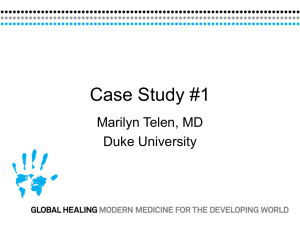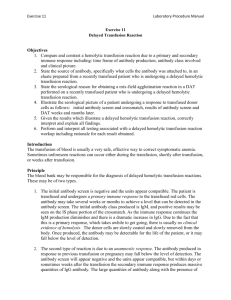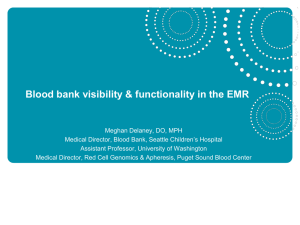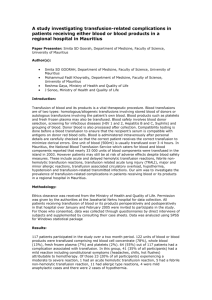Exercise 11
advertisement
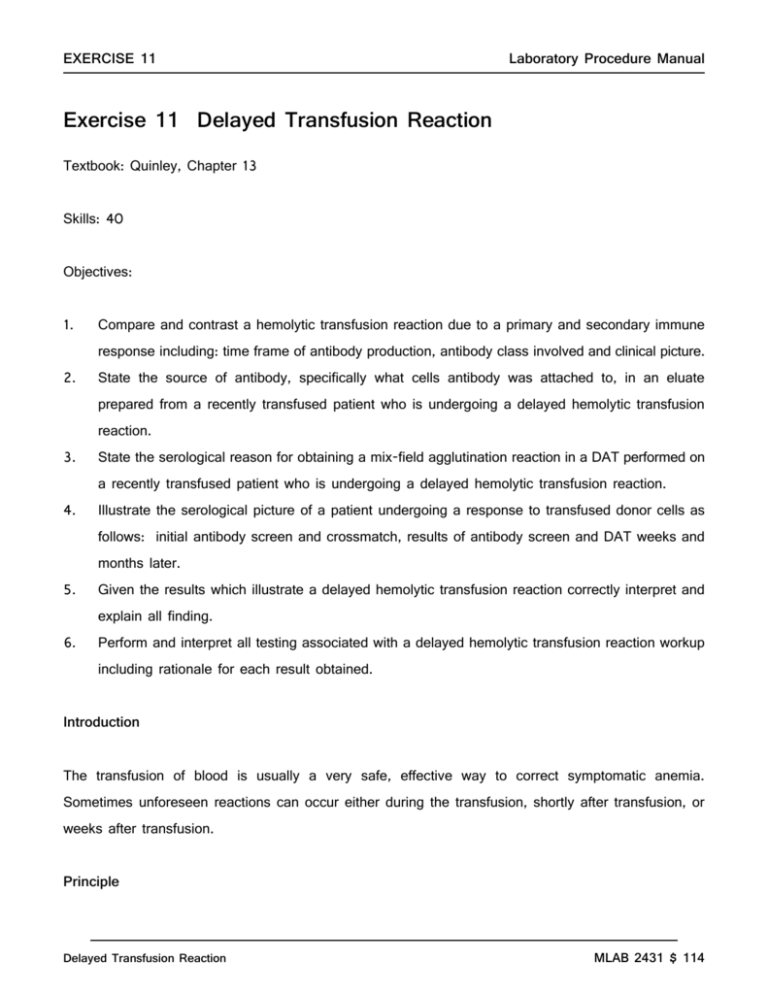
EXERCISE 11 Laboratory Procedure Manual Exercise 11 Delayed Transfusion Reaction Textbook: Quinley, Chapter 13 Skills: 40 Objectives: 1. Compare and contrast a hemolytic transfusion reaction due to a primary and secondary immune response including: time frame of antibody production, antibody class involved and clinical picture. 2. State the source of antibody, specifically what cells antibody was attached to, in an eluate prepared from a recently transfused patient who is undergoing a delayed hemolytic transfusion reaction. 3. State the serological reason for obtaining a mix-field agglutination reaction in a DAT performed on a recently transfused patient who is undergoing a delayed hemolytic transfusion reaction. 4. Illustrate the serological picture of a patient undergoing a response to transfused donor cells as follows: initial antibody screen and crossmatch, results of antibody screen and DAT weeks and months later. 5. Given the results which illustrate a delayed hemolytic transfusion reaction correctly interpret and explain all finding. 6. Perform and interpret all testing associated with a delayed hemolytic transfusion reaction workup including rationale for each result obtained. Introduction The transfusion of blood is usually a very safe, effective way to correct symptomatic anemia. Sometimes unforeseen reactions can occur either during the transfusion, shortly after transfusion, or weeks after transfusion. Principle Delayed Transfusion Reaction MLAB 2431 $ 114 EXERCISE 11 Laboratory Procedure Manual The blood bank may be responsible for the diagnosis of delayed hemolytic transfusion reactions. These may be of two types. 1. The initial antibody screen is negative and the units appear compatible. The patient is transfused and undergoes a primary immune response to the transfused red cells. The antibody may take several weeks or months to achieve a level that can be detected in the antibody screen. The initial antibody class produced is IgM, and positive results may be seen on the IS phase portion of the crossmatch. As the immune response continues the IgM production diminishes and there is a dramatic increase in IgG. Due to the fact that this is a primary response, which takes awhile to get going, there is usually no clinical evidence of hemolysis. The donor cells are slowly coated and slowly removed from the body. Once produced, the antibody may be detectable for the life of the patient, or it may fall below the level of detectability. 2. The second type of reaction is due to an anamnestic response. The antibody produced in response to previous transfusion or pregnancy may fall below the level of detectability. The antibody screen will appear negative and the units appear compatible, but within days or sometimes weeks after the transfusion the secondary immune response produces massive quantities of IgG antibody. The large quantities of antibody along with the presence of large quantities of transfused cells present in the patient's circulation may result in symptoms of hemolysis, i.e., jaundice, decrease in hemoglobin, increased reticulocyte count, decreased haptoglobin, etc. If more blood is ordered in the appropriate time frame the patient will have a positive DAT due to antibody coated donor cells in the circulation and a positive antibody screen. Once an antibody is identified in a patient=s serum the patient is antigen typed to confirm that they are negative for the antigen. Antigen typing cannot be performed on recently transfused patients. Their sample not only contains their own red blood cells, but the red blood cells of every donor they were transfused with. Cell separation techniques are available which can be used to separate patient cells from transfused cell. Once separated antigen typing can be performed. Reagents Delayed Transfusion Reaction MLAB 2431 $ 115 EXERCISE 11 1. See page 1 2. Gamma Elu Kit Laboratory Procedure Manual Procedure 1. Perform a 2 unit crossmatch on the patient sample. Use the patient and panel forms to record your results. 2. Follow the flow chart on the next page to determine additional testing to perform. 3. Use the AInterpretation of Results@ sheet to explain your findings. If you have any problems make an appointment with the instructor. The interpretation of results is a major portion of this lab grade. Delayed Transfusion Reaction MLAB 2431 $ 116 EXERCISE 11 Delayed Transfusion Reaction Laboratory Procedure Manual MLAB 2431 $ 117 EXERCISE 11 Delayed Transfusion Reaction Laboratory Procedure Manual MLAB 2431 $ 118 EXERCISE 11 Delayed Transfusion Reaction Laboratory Procedure Manual MLAB 2431 $ 119 EXERCISE 11 Laboratory Procedure Manual Procedure Gamma Elu-Kit II There are 2 steps to this procedure: 1. Preparing the eluate. 2. Testing the eluate. Follow the instructions very carefully. Preparing the Eluate 1. Spin EDTA tube for three (3) minutes. Place supernatant plasma in properly labeled tube. 2. Place 20 large drops of EDTA packed cells into the original EDTA cell suspension tube used for the DAT procedure. Label another tube with patients name and ALast Wash@, for the last wash control. 3. Wash the cells one time with saline, DO NOT decant, use a pipet to remove the supernatant saline. Wash an additional four times with the working wash solution to remove all unbound antibody using a pipet each time to remove and discard the supernatant saline. *Reserve a small aliquot of the supernate from the final wash to serve as a control. 4. Add 20 drops (1 ml) of Eluting Solution to the washed red blood cells, parafilm the top and mix GENTLY by inverting the tube four times. Centrifuge immediately for 60 seconds at 3400 rpms. NOTE: Prolonged immersion of the cells in Eluting Solution causes hemolysis. Delayed Transfusion Reaction The consequent release of hemoglobin into the MLAB 2431 $ 120 EXERCISE 11 Laboratory Procedure Manual eluate alters the pH and may affect the volume of Buffering Solution required to adjust the pH of the eluate to neutral. 5. Transfer the supernatant eluate (the fluid above the red cell layer) into a clean, properly labeled test tube. Discard the red cells. 6. To the separated acid eluate, add 20 drops (1 ml) of Buffering Solution. NOTE: The presence of a blue indicator in the Buffering Solution provides a means to determine that the eluate has been adjusted to within the required pH range for testing (6.4-7.6). When Buffering Solution is first added to a freshly prepared eluate, it will be noted to turn yellow on contact with the acid solution. As the volume of Buffering Solution approaches the original volume of eluate, however, the color changes to a pale blue. This persists upon mixing if the pH of the eluate has been adjusted to within the desired range. The volume of Buffering Solution required for this purpose may vary with different eluates, depending on a number of factors. If the color of the eluate remains yellow after adding 20 drops of Buffering Solution, continue to add Buffering Solution, one drop at a time, until a pale blue color persists upon mixing. 7. Mix well and centrifuge to remove any precipitate or cellular debris, then transfer eluate to a clean, properly labeled test tube. Testing the Eluate 1. Label 11 tubes for testing eluate with panel cells 1-11, and three (3) additional tubes for testing the last wash control (LW) with the 3 screen cells. 2. Place one drop of the panel cell (for eluate) and screen cell (for LW) to be tested in its appropriately labeled tube. Delayed Transfusion Reaction MLAB 2431 $ 121 EXERCISE 11 3. Laboratory Procedure Manual Add a small volume (approximately 10 drops) of saline to each tube. Mix well and centrifuge for 30 seconds. Decant completely and blot the tubes dry. 4. Add three (3) drops of eluate to each tube of panel cells. Add three (3) drops of last wash to each tube of screen cells. 5. Mix the contents of all tubes thoroughly and incubate at 37C for 15 minutes. Read the following carefully! 6. After appropriate incubation, add ten (10) drops of the working Wash Solution to the tube and mix well. 7. Centrifuge for 30 seconds. Decant the working Wash Solution completely and blot the tubes dry. 8. Without further washing, add two (2) drops of anti-human globulin serum to each tube and mix well. 9. Centrifuge immediately for 15 seconds. Resuspend the cells by gentle shaking, read for agglutination (macro- and microscopically) and record test results. 10. Add one (1) drop of Coombs Control Cells to all negative tubes. Mix and centrifuge. Agglutination must be obtained or test must be repeated. NOTE: Read reagent package insert for principle and limitations of the procedure. Reference Delayed Transfusion Reaction MLAB 2431 $ 122 EXERCISE 11 1. Laboratory Procedure Manual Gamma Elu-Kit II reagent package insert, 11-90 revision. Delayed Transfusion Reaction MLAB 2431 $ 123 EXERCISE 11 Laboratory Procedure Manual Name_________________________________ Date_________________________________ Delayed Transfusion Reaction Workup Interpretation of Results Patient History: Your patient was transfused during a surgical procedure 10 years ago. Two weeks ago the patient was transfused with 2 units of packed red blood cells during another surgical procedure. At that time the patient=s antibody screen was negative. The physician has requested two more units of blood on this patient due to a decrease of the patient=s hemoglobin. For each of the following state the results of your testing: 1. ABO/D and Antibody Screen results: 2. Were donor units compatible? 3. Result of panel (serum testing): 4. Result of DAT: Delayed Transfusion Reaction MLAB 2431 $ 124 EXERCISE 11 5. Laboratory Procedure Manual Result of panel (eluate): In your own words describe in detail what is happening to this patient. Correlate each test (1-5) with the next test performed, ie, why was it done, and how does the result fit in to the patient=s current serological picture. Name_________________________________ Exercise 11 Delayed Transfusion Reaction Work-Up Study Questions 1. Describe the hemolytic transfusion reaction due to a primary immune response specifically addressing the following: a. time frame Delayed Transfusion Reaction MLAB 2431 $ 125 EXERCISE 11 Laboratory Procedure Manual b. antibody class involved c. hemolysis of transfused cells 2. Describe the hemolytic transfusion reaction due to a secondary immune response specifically addressing the following: a. time frame b. antibody class involved c. Why are DAT results positive? d. List the additional laboratory testing and whether the results will be increased or decreased when immune hemolysis occurs. 3. Define Amixed-field@ agglutination. In a delayed hemolytic transfusion reaction whose cells are in the clumps seen? Why are these cells clumped? 4. Where does the antibody recovered in the eluate come from? 5. Explain why a recently transfused patient cannot be antigen typed. Delayed Transfusion Reaction MLAB 2431 $ 126

